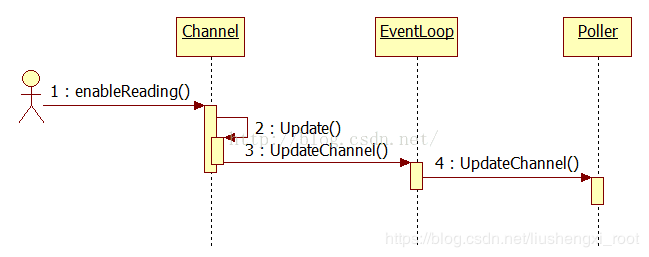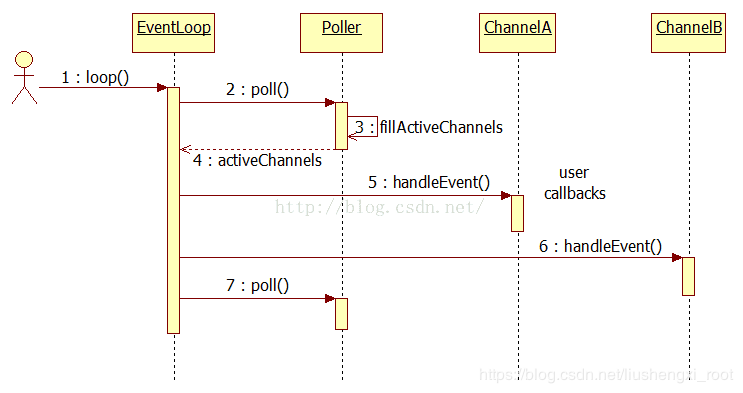muduo的事件處理(Reactor模型關鍵結構)
muduo的Reactor模式主要有3個類實現-Channel、Poller、EventLoop、定時器
1. 事件分發類 Channel (最終干活的)
Channel是selectable IO channel,自始至終只負責一個 fd 的(注冊與響應) IO 事件,但是不擁有該 fd ,所以也就在析構的時候不關閉它.
Channel自始至終都屬于一個EventLoop(一個EventLoop對應多個Channel,處理多個IO),自始至終只負責一個文件描述符的IO事件
EventLoop* loop_;
const int fd_;
int events_;
int revents_;
int index_;
ReadEventCallback readCallback_;
EventCallback writeCallback_;
EventCallback errorCallback_;
EventCallback closeCallback_;
幾個callback函數都是c++新標準里面的function對象(muduo里面是Boost::function),它們會在handleEvent這個成員函數中根據不同的事件被調用。index_是poller類中pollfds_數組的下標。events_和revents_明顯對應了struct pollfd結構中的成員。需要注意的是,Channel并不擁有該fd,它不會在析構函數中去關閉這個fd(fd是由Socket類的析構函數中關閉,即RAII的方法),Channel的生命周期由其owner負責。
如何工作?
在Channel類中保存這IO事件的類型以及對應的回調函數,當IO事件發生時,最終會調用到Channel類中的回調函數
具體流程如下:
首先給定Channel所屬的 loop,及其要處理的 fd;接著注冊 fd 上需要監聽的事件,如果是常用的讀寫事件的話,可以直接調用接口函數enableReading或enableWriting來注冊對應fd上的事件,disable* 是銷毀指定的事件;然后通過 setCallback 來設置事件發生時的回調即可
注冊事件時函數調用關系,如下:Channel::update()->EventLoop::updateChannel(Channel)->Poller::updateChannel(Channel),最終向 poll 系統調用的監聽事件表注冊或修改事件。

2. IO multiplexing 類 Poller
Poller是個基類,具體可以是EPollPoller(默認) 或者PollPoller,對應 epoll 和 poll.需要去實現(唯一使用面向對象的一個類)
typedef std::vector<struct pollfd> PollFdList;
typedef std::map<int, Channel*> ChannelMap; // fd to Channel
PollFdList pollfds_;
ChannelMap channels_;
ChannelMap是fd到Channel類的映射,PollFdList保存了每一個fd所關心的事件,用作參數傳遞到poll函數中,Channel類里面的index_即是這里的下標。Poller類有下面四個函數
Timestamp poll(int timeoutMs, ChannelList* activeChannels);
void updateChannel(Channel* channel);
void removeChannel(Channel* channel);
private:
void fillActiveChannels(int numEvents, ChannelList* activeChannels) const;
updateChannel和removeChannel都是對上面兩個數據結構的操作,poll函數是對::poll的封裝。私有的fillActiveChannels函數負責把返回的活動時間添加到activeChannels(vector<Channel*>)這個結構中,返回給用戶。Poller的職責也很簡單,負責IO multiplexing,一個EventLoop有一個Poller,Poller的生命周期和EventLoop一樣長。
是eventloop的成員,它的職責僅僅是IO復用,事件分發交給 Channel 完成,生命期和 EventLoop 一樣長。
poll函數調用 epoll_wait/poll 來監聽注冊了的文件描述符,然后通過fillActiveChannels函數將返回的就緒事件裝入 activeChannels 數組

3. EventLoop 類
EventLoop類是核心,大多數類都會包含一個EventLoop*的成員,因為所有的事件都會在EventLoop::loop()中通過Channel分發。先來看一下這個loop循環:
while (!quit_)
{
activeChannels_.clear();
pollReturnTime_ = poller_->poll(kPollTimeMs, &activeChannels_);
for (ChannelList::iterator it = activeChannels_.begin();
it != activeChannels_.end(); ++it)
{
(*it)->handleEvent(pollReturnTime_);
}
doPendingFunctors();
}
handleEvent是Channel類的成員函數,它會根據事件的類型去調用不同的Callback。循環末尾還有一個doPendingFunctors(),這個函數的作用在后面多線程的部分去說明。
EventLoop類是Reactor模式的核心,一個線程一個事件循環,即one loop per thread,EventLoop 對象的生命周期通常與其所屬的線程一樣長。EventLoop對象構造的時候,會檢查當前線程是否已經創建了其他EventLoop對象,如果已創建,終止程序(LOG_FATAL),EventLoop類的構造函數會記錄本對象所屬線程(threadld_),創建了EventLoop對象的線程稱為IO線程.其主要功能是運行事件循環,等待事件發生,然后調用回調處理發生的事件。EventLoop::loop() -> Poller::poll()填充就緒事件集合 activeChannels,然后遍歷該容器,執行每個 channel的 Channel::handleEvent() 完成對應就緒事件回調。

由上面三個類已經可以構成Reactor的核心,整個流程如下:
用戶通過Channel向Poller類注冊fd和關心的事件
EventLoop從poll中返回活躍的fd和對應的Channel
通過Channel去回調相應的時間。
4. TimerQueue
typedef std::shared_ptr<Timer> TimerPtr;
typedef std::pair<Timestamp, TimerPtr> Entry;
typedef std::set<Entry> TimerList;
Channel timerfdChannel_;
const int timerfd_;
TimerList timers_;
采用std::pair<Timestamp, TimerPtr> 加上set的 的形式是為了處理兩個Timer同事到期的情況,即使到期時間相同,它們的地址也不同。timerfdChannel_是用來管理timerfd_create函數創建的fd。Timer類里面包含了一個回調函數和一個到期時間。expiration_就是上面Entry中的Timestamp。
const TimerCallback callback_;
Timestamp expiration_;
用一個set來保存所有的事件和時間
根據set集合里面最早的時間來更新timerfd_的到期時間(用timerfd_settime函數)
時間到期后,EventLoop的poll函數會返回,并調用timerfdChannel_里面的handleEvent回調函數。
通過handleEvent這個回調函數,再去處理到期的所有事件。
timerfdChannel_.setReadCallback(
std::bind(&TimerQueue::handleRead,this));
timerfdChannel_.enableReading();
timerfdChannel_的callback函數注冊了TimerQueue的handleRead函數。在handleRead中應該干什么就很明顯了,自然是撈出所有到期的timer,一次去執行對應的事件
void TimerQueue::handleRead()
{
loop_->assertInLoopThread();
Timestamp now(Timestamp::now());
readTimerfd(timerfd_, now);
std::vector<Entry> expired = getExpired(now);
// safe to callback outside critical section
for (std::vector<Entry>::iterator it = expired.begin();
it != expired.end(); ++it)
{
it->second->run();
}
reset(expired, now);
}
多線程的技巧
一個線程一個EventLoop,每個線程都有自己管理的各種ChannelList和TimerQueue。有時候,我們總有一些需求,要在各個線程之間調配任務。比如添加一個定時時間到IO線程中,這樣TimerQueue就有兩個線程同時訪問。
1. runInLoop()和queueInLoop()
先來看幾個EventLoop里面重要的函數和成員:
std::vector<Functor> pendingFunctors_; // @GuardedBy mutex_
void EventLoop::runInLoop(Functor&& cb) {
if (isInLoopThread()) {
cb();
} else {
queueInLoop(std::move(cb));
}
}
void EventLoop::queueInLoop(Functor&& cb) {
{
MutexLockGuard lock(mutex_);
pendingFunctors_.push_back(cb);
}
if (!isInLoopThread() || callingPendingFunctors_) {
wakeup();
}
}
注意這里的函數參數,我用到了C++11的右值引用。
在前面的EventLoop::loop里面,我們已經看到了doPendingFunctors()這個函數,EventLoop還有一個重要的成員pendingFunctors_,該成員是暴露給其他線程的。這樣,其他線程向IO線程添加定時時間的流程就是:
其他線程調用runInLoop(),
如果不是當前IO線程,再調用queueInLoop()
在queueLoop中,將時間push到pendingFunctors_中,并喚醒當前IO線程
注意這里的喚醒條件:不是當前IO線程肯定要喚醒;此外,如果正在調用Pending functor,也要喚醒;(為什么?,因為如果正在執行PendingFunctor里面,如果也執行了queueLoop,如果不喚醒的話,新加的cb就不會立即執行了。)
2.doPendingFunctors()
void EventLoop::doPendingFunctors() {
std::vector<Functor> functors;
callingPendingFunctors_ = true;
{
// reduce the lenth of the critical section
// avoid the dead lock cause the functor can call queueInloop(;)
MutexLockGuard lock(mutex_);
functors.swap(pendingFunctors_);
}
for (size_t i = 0; i < functors.size(); ++i) {
functors[i]();
}
callingPendingFunctors_ = false;
}
doPendingFunctors并沒有直接在臨界區去執行functors,而是利用了一個棧對象,把事件swap到棧對象中,再去執行。這樣做有兩個好處:
減少了臨界區的長度,其它線程調用queueInLoop對pendingFunctors加鎖時,就不會被阻塞
避免了死鎖,可能在functors里面也會調用queueInLoop(),從而造成死鎖。
回過頭來看,muduo在處理多線程加鎖訪問共享數據的策略上,有一個很重要的原則:拼命減少臨界區的長度
試想一下,如果沒有pendingFunctors_這個數據成員,我們要想往TimerQueue中添加timer,肯定要對TimerQueue里面的insert函數加鎖,造成鎖的爭用,而pendingFunctors_這個成員將鎖的范圍減少到了一個vector的push_back操作上。此外,在doPendingFunctors中,利用一個棧對象減少臨界區,也是很巧妙的一個重要技巧。
3.wake()
前面說到喚醒IO線程,EventLoop阻塞在poll函數上,怎么去喚醒它?以前的做法是利用pipe,向pipe中寫一個字節,監視在這個pipe的讀事件的poll函數就會立刻返回。在muduo中,采用了linux中eventfd調用
static int createEventfd() {
int evtfd = ::eventfd(0, EFD_NONBLOCK | EFD_CLOEXEC);
if (evtfd < 0) {
LOG_SYSERR << "Failed in eventfd";
abort();
}
return evtfd;
}
void EventLoop::wakeup() {
uint64_t one = 1;
ssize_t n = ::write(wakeupFd_, &one, sizeof one);
if (n != sizeof one) {
LOG_ERROR << "EventLoop::wakeup() writes " << n << " bytes instead of 8";
}
}
把eventfd得到的fd和前面一樣,通過Channel注冊到poll里面,喚醒的時候,只需要向wakeupFd中寫入一個字節,就能達到喚醒的目的。eventfd、timerfd都體現了linux的設計哲學,Everyting is a fd。
參考
[2]基本網絡編程范式 https://segmentfault.com/a/1190000005910673



 浙公網安備 33010602011771號
浙公網安備 33010602011771號